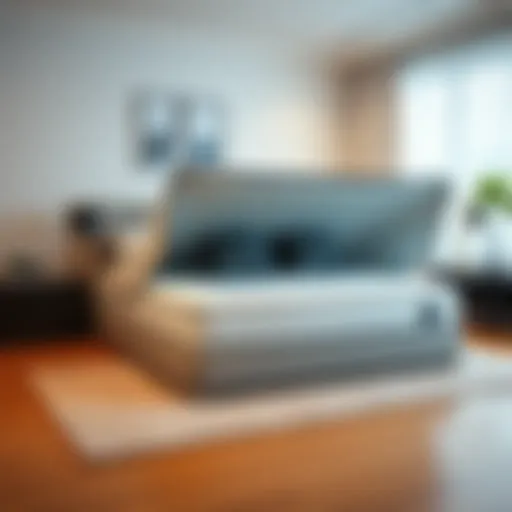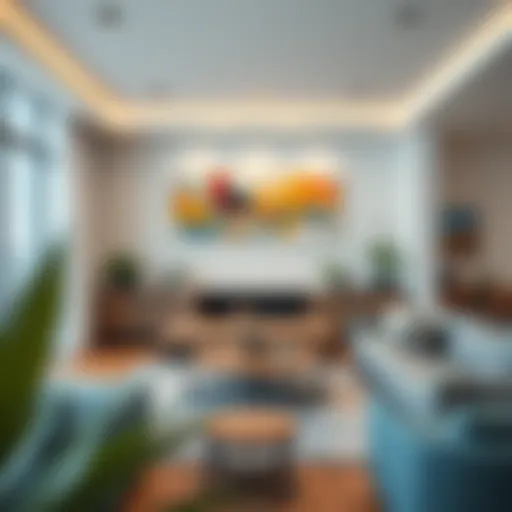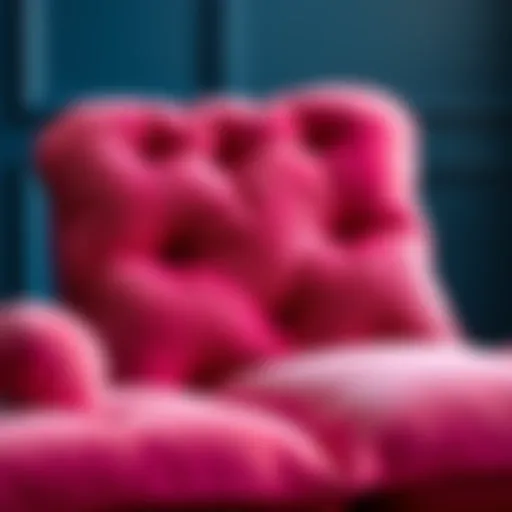Designing Your Space: Room Designs Made Easy Online


Intro
As homeowners, renters, or designers, the space we inhabit says a lot about us. It not only reflects our personality but also serves practical needs. In recent years, the rise of online tools has revolutionized how we approach this vital aspect of our lives. The ability to design our spaces digitally has turned what was once a painstakingly manual endeavor into an exciting and accessible venture. You no longer need to be a professional designer or inherit a talent for aesthetics—today, all you need is a computer and a dose of creativity to get started.
The online design landscape is ceaselessly evolving, with a plethora of software options and platforms available. From sophisticated 3D modeling tools to user-friendly apps, the choices can be overwhelming. However, the fundamental principles remain constant. As you embark on this design journey, it's crucial to harness both the technology available and your unique style to create a space that genuinely feels like home.
In this article, we’ll explore the latest furniture trends, provide insights into DIY projects, and discuss various tools and techniques that can help you navigate the digital world of interior design. By the end, you’ll not only be equipped with the knowledge needed to redesign your room but also encouraged to express yourself through thoughtful and innovative design choices.
So, let’s dive deep into the realm of online room design and gain a comprehensive understanding of its nuances and opportunities.
Preamble to Online Room Design
Designing a room is not just about placing furniture in a space; it's a thoughtful process that shapes how we interact with our environment. In today’s digital age, online room design has transformed this process, making it simpler and more accessible to everyone. Whether you're a seasoned designer or someone simply looking to spruce up their living room, understanding the nuances of online room designing is essential. It allows for creativity while also addressing practical concerns, blending personal style with functional needs.
Online design tools are akin to a painter’s canvas, providing a platform where ideas can flourish without the immediate constraints of reality. You can explore and visualize layouts, colors, and styles right from your screen at home. This evolution hasn’t just made space planning easier but has also democratized interior design. No longer do you need to hire a professional to envision your dream space; with just a few clicks, homeowners, renters, and DIYers can bring their imagination to life.
The benefits of online room design are numerous. For starters, many of these platforms are user-friendly, allowing even those with minimal tech skills to navigate with ease. Additionally, these digital spaces foster collaboration and sharing, enabling users to receive feedback from friends or family in real-time. Ultimately, the key consideration here is that online room design is about empowerment—empowering individuals to craft spaces that reflect their individuality.
"Online design tools are a gateway to personal expression, making the design process less intimidating and more enjoyable."
As we navigate this section, we will delve into the evolution of interior design and how it has transitioned over the years, particularly with the advent of technology. By understanding this journey, we can better appreciate the tools at our disposal today.
The Evolution of Interior Design
Traditionally, interior design was often seen as an arena reserved for the elite. Professional designers mapped out spaces with a handful of materials and color palettes, guiding clients through their vision. However, the landscape has shifted considerably from the days of exclusive design.
The advent of the internet opened the floodgates to new ideas and inspirations, transforming the way people perceive and approach interior design. Nowadays, anyone can peruse a seemingly endless array of styles, trends, and methods. Online resources have become archives of information where ideas flutter freely, allowing anyone to merge aesthetics with functionality. With platforms that now host thousands of images, the possibilities feel endless.
What’s more, the rise of social media has painted a vibrant picture of interior design. Instagram, Pinterest, and other platforms offer a treasure trove of visual inspiration that can lead to new trends every season. Homeowners and designers alike can now track what works in real-time, gathering insights that were previously limited to professional circles. This rich heritage of design knowledge is not just a blink in history; each shift reinforces a culture of innovation and exploration in renovating and designing spaces.
The Role of Technology in Modern Design
Technology has taken center stage in revolutionizing how we approach interior design today. It’s no longer confined to an app or a software suite; instead, it permeates every aspect of the design process. From augmented reality tools that let you visualize a sofa in your living room before you buy it to virtual reality rooms where you can wander through spaces you'll design, the impact is profound.
Moreover, technology caters to various facets of design.
- 3D modeling software enables users to create accurate representations of spaces, making it easier to visualize dimensions and layouts.
- Virtual reality gives an immersive experience, allowing you to walk through your plans before implementation.
- Collaboration tools let groups work together across distances, bringing diverse perspectives into play.
Thanks to these advancements, anyone can experiment with styles and designs, ensuring that their choices are both informed and personal. It's about uniting artistry with science, allowing creativity to thrive within structured parameters. The digital landscape continually evolves, challenging designers and homeowners to think critically and innovatively.
In summary, understanding online room design taps into a broader narrative of how interiors reflect our lives, preferences, and the advancements that shape our approach to creating spaces. Embracing this evolution not only enhances personal style but also aligns with the practical realities of modern living.
Choosing the Right Design Software
Choosing the right design software is crucial for anyone looking to create visually appealing and functional spaces online. The world of interior design has evolved with technology, and now various software solutions offer unique features that cater to diverse design needs. Whether you are a seasoned designer or a DIY enthusiast, selecting the right tool can make all the difference in how effectively you translate your vision into reality.
When evaluating design software, consider the complexity of your projects and your comfort level with technical tools. Sophisticated software might come with a steep learning curve, but often offers enhanced capabilities. On the other hand, user-friendly programs are readily accessible and can yield impressive results without overwhelming the user. The ideal software strikes a balance between functionality and ease of use, allowing you to focus on your creativity instead of navigating through complicated features.
Key takeaway: Picking the right software can enhance your design process, maximize your efficiency, and ultimately help you create designs that resonate with your personal style or client needs.
Features to Look For in Software
When selecting the right design software, it’s vital to keep an eye out for specific features that set one option apart from another. Here are some features that can significantly improve your design experience:
- User Interface: A clean and intuitive layout makes it easier to find tools and features. Avoid software that requires a flowchart to figure out how to get started.
- Customization Options: Look for platforms that allow you to customize colors, textures, and furnishings to fit your personal aesthetic. This flexibility can aid in better project visualization.
- 3D Capabilities: Three-dimensional modeling can provide a more realistic perspective of your space, making it easier to visualize how different elements will come together.
- Collaboration Features: If you’re working as part of a team, check for built-in tools that allow sharing and real-time feedback.
- Templates and Resources: Having access to templates can save time and help you start designs without redesigning the wheel. Good software comes with a library of designs that can inspire or directly assist you in your project.
Comparative Analysis of Popular Tools
In the crowded market of design software, several tools stand out based on their features, usability, and user feedback. Here’s a comparative look at some popular options:
- SketchUp: Widely regarded for its 3D modeling capabilities, SketchUp offers a user-friendly experience and is ideal for both pros and newbies. It also features robust community support with countless plugins.
- Floorplanner: Great for creating floor plans, Floorplanner stands out for its extensive library of furniture and decor styles. It’s highly regarded for its simplicity and effective communication tools for collaborative projects.
- Roomstyler 3D Home Planner: This tool enables users to drag and drop items into floor plans effortlessly. Its realistic 3D rendering helps users see how their designs play out in real life.
- Homestyler: Tailored for ambitious DIYers and homeowners, Homestyler offers an impressive array of templates and 3D visualizations to make the design process simpler and more enjoyable.
Ultimately, the right tool revolves around your personal needs. Don’t hesitate to experiment with a few different platforms until you find the one that clicks with your design style.
Understanding User Interfaces
When it comes to designing spaces online, the user interface (UI) plays a crucial role in shaping the entire experience. A good interface acts like a guiding hand, leading you through the various tools and features available in design software. It’s important not to underestimate how a well-designed UI can transform a daunting task into a smooth and enjoyable process. Understanding the principles of user interfaces can make all the difference in how effectively you engage with the design platforms.
Navigating Design Platforms Seamlessly
Navigating through design platforms shouldn’t feel like learning to fly a plane blindfolded. Instead, the goal is to have a user-friendly experience that lets you explore possibilities without unnecessary frustration. An intuitive navigation system is key, enabling users to find everything from color palettes to furniture options with ease.
Some common aspects that contribute to seamless navigation include:
- Clear Menus: Dropdown menus and tabs that are logically organized help users quickly locate various tools. A simple click should take you where you need to go without complications.
- Guided Tutorials: Many platforms offer step-by-step guides that help you get a grip on the software right from the start. Engaging tutorials can also reduce the steep learning curve typically associated with design tools.
- User Feedback: Platforms that incorporate feedback mechanisms allow users to report difficulties. This reduces headaches for future users as modifications can be made based on collective experiences.
Customizing Your Experience
Customization is where your style and preferences start to take center stage. Every designer has unique tastes, and being able to tailor the UI to fit these idiosyncrasies is essential. Adjusting settings to suit personal workflows can elevate productivity and enhance the design process. Here are some ways to customize your experience:
- Drag-and-Drop Functionality: This feature can make placing items into your design space feel as smooth as butter. The ability to rearrange furniture and decor with a few clicks promotes a playful and experimental approach to layout design.
- Workspace Layout: Many platforms enable users to rearrange panels and toolbars based on personal workflow. If you’re more comfortable with certain tools, positioning them for quick access can boost your efficiency.
- Keyboard Shortcuts: Familiarizing yourself with keyboard shortcuts can shave off precious minutes, making navigation quicker while allowing you more time to focus on the creative aspects of your design.
Incorporating Design Principles
Incorporating design principles into your online room design process is akin to laying the foundation for a sturdy house. It sets the tone and function, ensuring that every element serves a purpose while contributing to the overall aesthetic. Understanding these principles can make or break your design—it's not just about tossing furniture around or picking colors that look nice together. It's about creating harmony, addressing spatial dynamics, and ultimately crafting a sanctuary tailored to your needs.
Balancing Aesthetics and Functionality
When diving into the world of room design, aesthetics and functionality often appear as two sides of the same coin. The interplay between the two is crucial; after all, a room might look stunning, but if it can't serve its primary purpose, it becomes nothing more than a vessel for pretty decor.
Consider this: a cozy living room with an elegant sofa. If the sofa's placement blocks pathways or makes conversation awkward, the allure fades fast. Thus, while choosing a stunning piece, ensure that it fits the room's function. Here are tips to help strike the perfect balance:
- Prioritize Layout: Visualize how you will be using the space. For example, a well-placed coffee table can define the seating area, making it livable.
- Choose Multifunctional Pieces: Invest in furniture that doubles up on functionality, like an ottoman that serves as storage. This choice caters not just to aesthetics but also maximizes utility.
- Incorporate Scale: Make sure your pieces don’t just fit visually but also operationally. A large sectional sofa might overpower a small room, making it feel claustrophobic, while undersized furniture can cause the space to feel barren.
Achieving the right balance is a meticulous task but pays off richly when you can effortlessly navigate a beautiful yet functional space.
The Importance of Proportion and Scale
Proportion and scale are foundational aspects that underpin good design. They dictate how elements in a room relate to one another.


Take a moment and picture this: you walk into a room where the sofa looks dwarfed by towering bookshelves. Instinctively, it feels off-kilter, doesn’t it?
Understanding proportion requires an appreciation for the size of furniture in relation to the room and other objects within it. Here are a few pointers to keep in mind:
- Establish a Focal Point: Decide what the focal point of your room will be—it's usually a piece of art, a fireplace, or even a statement piece of furniture. From there, everything else can follow suit.
- Consider Height Variations: Mix tall and short elements to create visual interest. This variety can guide movement, keeping the eye engaged without overwhelming it.
- Leverage Digital Tools: Many online design platforms allow you to simulate your room. Manipulating proportion and scale digitally can prevent mismatches before the furniture enters your room.
Incorporating these principles into your design process ensures that you create spaces that not only feel right but look intentional as well. So take the time to analyze proportions and scale, allowing your space to breathe while making striking visual statements. “Good design is all about balance” is a truism in the world of room aesthetics; let that guide your decisions.
Creating Mood Boards
Creating mood boards is arguably one of the most riveting phases in the design process. These visual compilations serve as a powerful tool for translating thoughts, emotions, and aspirations into a tangible format. They help articulate a unique design narrative, capturing your style while allowing you to explore ideas before the actual implementation begins. Understanding the nuances of this practice can elevate your design game significantly.
Defining Your Style
When pulling together a mood board, it’s vital to first nail down your personal style. Are you inclined toward the sleek minimalism of Scandinavian design, or does bohemian decor resonate more with you? Defining your style helps in curating a set of visuals that reflect your taste and preferences. This isn’t just about collecting pretty pictures; it’s about finding elements that speak to you and reflect your personality. Consider aspects like color palettes, materials, and the overall vibe you aim for in your space. A good exercise is to list adjectives that describe how you want your room to feel, such as "cozy," "elegant," or "functional."
Using Digital Tools for Mood Boards
In the age of technology, utilizing digital tools to create your mood board can streamline the process. Platforms like Pinterest or Canva offer intuitive features that allow users to drag and drop images, play with layout, and even add text. A simple search can yield an array of images that align with your defined style, letting you visualize how disparate elements can coexist. Another beneficial aspect is that these tools typically allow for easy editing and reorganization. This flexibility is crucial when discovering which components harmonize best together.
Benefits of Digital Mood Boards:
- Easy Access: All your inspirational content is housed in a singular space.
- Shareability: Collaborate effortlessly with friends or professionals by sharing the digital mood board.
- Adaptable: Quickly swap out images or alter layouts as your ideas evolve.
Inspiration Sources: Online and Offline
Inspiration can be found everywhere, but knowing where to look makes all the difference. Online, platforms like Instagram and design blogs offer a treasure trove of ideas. Use hashtags relevant to your desired aesthetics, like #InteriorInspo or #ModernDesign, to hunt down images that resonate with you. However, don’t underestimate offline sources. Magazines such as Architectural Digest or Elle Decor can spark something unexpected. Even a stroll in your neighborhood may provide insight; take note of the colors and textures that stand out as you walk past different homes.
"Inspiration is everywhere. You just have to know where to look, and sometimes the most rewarding ideas come from the least expected places."
As you gather these visuals—whether they be screenshots from a blog, snippets from a magazine, or photos of settings—remember to focus on the elements that evoke a specific feeling. It’s not merely a collection of images; it’s about piecing together a narrative that reflects who you are and the space you wish to create.
Room Layout Considerations
When diving into the realm of online room design, layout holds significant weight. It’s the backbone upon which you build your aesthetic and functionality. An effective layout lays the ground for a harmonious space, fostering both comfort and usability. This section explores imperative elements to consider, the advantages they bring to your design, and how such considerations can dramatically influence the final outcome of your project.
Creating Functional Spaces
Designing functional spaces is akin to crafting a well-oiled machine. Each component must serve a purpose, whether it’s a cozy reading nook in your living room or an organized workspace in your home office. When arranging furniture, it’s crucial to think about how each element will function together:
- Zoning: Highlight different areas for specific activities. For example, a kitchen island can serve as both an eating space and a prep area.
- Proximity: Keep related items close together; for instance, kitchen utensils should be within arm’s reach when cooking.
- Accessibility: Ensure that all furniture is easy to reach and navigate around.
Thoughtful arrangements nurture a fluidity in motion. Take time to analyze how your daily routines flow. Adjusting elements according to your habits can make a world of difference in the efficiency of your space.
"A well-planned layout can make a tiny space feel enormous and an elegant space feel inviting."
Designing with Traffic Flow in Mind
Designing with traffic flow is the unsung hero of effective room layouts. Imagine walking through your space: you want to glide from one section to another, not feel tripped up by furniture placement. Here are some core tips to keep in mind:
- Wide Pathways: Allow enough space for natural movement. Generally, 30 to 36 inches provides a comfortable walking path between functional zones.
- Natural Lines: Follow the natural flow of your space. Arrange furniture parallel to walls or in a way that directs attention to focal points like fireplaces or windows.
- Avoiding Clutter: Too much stuff can funnel foot traffic into tiny areas. Maintaining a clean look eases flow and provides the illusion of more space.
Balancing aesthetics with function is a challenging feat. However, achieving a layout that supports seamless movement can enhance the overall experience of your home. By recognizing the importance of layout and taking the time to consider these facets, you open up a world of potential in your online design journey.
Color Theory in Design
Color theory plays a pivotal role in the realm of interior design, acting as the foundation on which aesthetic decisions are made. It doesn’t merely concern which hues pair well but delves into how colors influence emotions and behavior, ultimately shaping the spaces we inhabit. This theory is crucial in online room design, as users must navigate a vast array of color options that can drastically alter the ambiance of a space. Through understanding this, homeowners, renters, and even seasoned designers can forge environments that resonate personally and function optimally.
The Psychological Impact of Color
Colors carry meanings and evoke feelings, often without the mind realizing it. Consider, for instance, the calming nature of blue. When used in a bedroom, it could signal tranquility and peace, creating an ideal space for rest. On the flip side, bold reds can stimulate energy and excitement, making them more suitable for social spaces like a lively kitchen or trendy dining area.
- Warm Colors: These include reds, oranges, and yellows. They typically evoke warmth and energy, promoting social interaction. In a room designated for gatherings, warm colors can spark conversation and social connection.
- Cool Colors: Colors like blues, greens, and purples tend to evoke calmness and relaxation. They are often utilized in spaces meant for unwinding, such as bedrooms or reading nooks.
- Neutrals: White, gray, and beige act as balance points in a design scheme. They are flexible and can help highlight other colors while providing necessary breathing space.
Ultimately, the psychological impact of colors shapes not only how a space looks but also how it feels to those who use it. Understanding this can empower individuals and designers alike to select hues that fulfill both functional and emotional objectives.
Choosing Color Schemes Online
When venturing into the world of online room design, the selection of a color scheme can feel like navigating through a maze. With countless options available, focusing on a few guiding principles can streamline the decision-making process.
- Define Your Purpose: What do you want the room to express? Is it a space for relaxation, concentration, or socializing? Identifying the purpose will help establish a fitting color scheme.
- Use Available Tools: Many online design tools offer color wheels and scheme generators. For instance, tools like Coolors or Adobe Color can help visualize combinations that might work well together.
- Experiment with Palettes: Don’t hesitate to play around. Online tools allow you to test colors together in a virtual layout, helping you see how they interact in the space before making commitments.
- Consider Lighting: Remember that colors can look different in various lighting situations. Examine your chosen colors throughout different times of day to ensure satisfaction with the effects discovered.
By thoughtfully navigating the selection of color schemes online, designers and homeowners can cultivate spaces that genuinely reflect their personality while fulfilling practical needs.
Selecting Furnishings and Decor
Selecting the right furnishings and decor is not just about picking what looks nice; it's about creating an environment that resonates with your personal style and enhances the functionality of your space. This process often defines the character of a room, allowing you to communicate your tastes, values, and lifestyle without uttering a single word. The choices made here can warm up a cold room, create a sense of spaciousness in a cramped area, or make a bold statement about who you are.
When tackling furnishing and decor, several key elements come into play.
- Functionality: Consider how the room will be used. Is it a gathering place for family and friends, or a serene personal retreat? Every piece selected should align with the primary function of that room.
- Coherence: Aim for a cohesive look. A mix or match could end up making a space feel chaotic rather than curated. Sticking to a set color palette or thematic style can work wonders.
- Comfort: While aesthetics are crucial, comfort holds equal weight. There's no point in having the trendiest sofa if it's as pleasant to sit on as a bed of nails.
- Quality: Invest in items that will endure over time. Not only will this save you money in the long run, but it will also support sustainability.
In summary, the choosing of furnishings and decor is a multifaceted endeavor that lays the groundwork for the entire design of your home. It's essential to take a thoughtful approach, weighing each decision against the desired outcome of the space.
Virtual Shopping: Pros and Cons
With the digital age in full swing, virtual shopping has taken center stage when it comes to selecting furnishings and decor. This approach offers several advantages, along with a few potential pitfalls.
Pros:
- Convenience: Shop from the comfort of your home, browsing countless options without the exhaustion of navigating crowded stores.
- Wider Selection: Online marketplaces often feature a more extensive array of choices than physical stores could ever offer.
- Price Comparison: It's easier to compare prices across different platforms, potentially leading to great finds and savings.
Cons:
- Inability to Touch and Feel: Purchasing items sight unseen can lead to surprises, both good and bad. How a couch looks online may not match its reality.
- Shipping Delays: Unlike picking up a product the same day, online shopping often involves waiting, which can be frustrating if you're eager to set up your space.
- Returns Hassles: The return policy can be a double-edged sword, putting the onus on you to repackage and ship items back if they aren't a perfect fit.
Ultimately, navigating the world of virtual shopping for furnishings requires a blend of careful consideration and a bit of adventurous spirit. The key lies in being informed and making choices that work for you.
Eco-Friendly Options for Sustainable Living
Sustainability isn't just a trend; it's becoming a critical consideration in home design. As homeowners and renters become more conscious of their environmental footprints, the demand for eco-friendly furnishings and decor is on the rise. Choosing sustainable options not only speaks to a more ethical lifestyle, but it's also often synonymous with higher quality and longevity in products.


- Materials Matter: Look for furnishings made from reclaimed wood, bamboo, or organic cotton. These materials are not only better for the earth but can also introduce unique character and warmth to your space.
- Local Sourcing: Whenever possible, think about purchasing from local artisans or stores. This not only supports local economies but also minimizes the carbon footprint associated with shipping goods over long distances.
- Minimalism: Embracing a minimalist mindset can lead to a more sustainable lifestyle. Reducing clutter and opting for a few high-quality items rather than a myriad of less meaningful decor promotes a sense of peace and clarity in your surroundings.
Adopting eco-friendly options is about more than just products; it's about fostering an ethos that elevates your home while caring for the planet. Embracing sustainable practices sets a precedent for others, showcasing that design can be both beautiful and responsible.
"The earth provides enough to satisfy every man's needs, but not every man's greed." - Mahatma Gandhi
By seeking out responsible choices, you'll be creating a home that not only pleases the eye but also aligns with your values.
Implementing Lighting Solutions
Lighting is much more than just a practical necessity in home design. It sets the mood, influences the perception of space, and highlights your carefully curated decor. When designing your space online, implementing effective lighting solutions is critical. The right lighting can transform a mundane room into a warm, inviting environment, whereas poor lighting can overshadow even the best layout or furnishings.
Natural vs. Artificial Light
One cannot overlook the significance of natural light in any space. It provides a sense of freshness and openness that artificial light often fails to replicate. Natural sunlight has this uncanny ability to brighten spaces, lift spirits, and create a sense of well-being. It is wise to maximize daylight by positioning mirrors strategically or using sheer curtains that enhance the flow of sunlight. This choice not only promotes a lively atmosphere but can also save energy costs, making your design both aesthetic and functional.
However, one must not dismiss artificial light. While natural light reigns during the day, it is artificial lighting that plays the critical role when the sun dips below the horizon. Various types of artificial lighting serve different functions. Ambient light illuminates the overall space, task light, such as desk lamps, provides focused illumination, while accent lighting can highlight artwork or architectural features.
"Proper lighting enhances the aesthetic appeal of your design while meeting practical needs. Spacing out different light sources and considering their placements can create a harmonious balance in any room."
Smart Lighting in Home Design
In an age where technology permeates every aspect of our lives, lighting design has also caught the digital wave. Smart lighting is revolutionizing how we think about illumination in our homes. With smart bulbs and systems, you can control lighting from your smartphone or voice commands. Imagine dimming the lights for movie night or setting them to slowly brighten in the morning, mimicking a natural sunrise.
Beyond convenience, smart lighting can enhance energy efficiency. For example, use sensors to turn off lights when a room is unoccupied or to adjust brightness based on the amount of natural light entering the room. This means fewer wasted energy units and lower bills.
A few practical considerations when introducing smart lighting into your design:
- Compatibility: Ensure the smart lighting system you select can integrate well with existing home automation systems.
- User Experience: Choose a system with an intuitive app interface for ease of use.
- Expandability: Opt for systems that allow you to start small but offer room for future upgrades or additional fixtures.
Smart lighting serves not just functional purposes but also aesthetic ones. Through programmable features, you can create various scenes for different occasions, molding the atmosphere of your space to fit your mood.
As you consider your design, always return to the foundation of effective lighting. With a blend of natural lights, calculated artificial sources, and smart technology, you’ll create a sanctuary that feels just right.
Staying Current with Design Trends
Staying abreast of design trends is pivotal for anyone looking to enhance their living spaces. In a world that constantly evolves, where design preferences shift like sands in an hourglass, understanding current trends ensures that your space feels modern and attractive. Not just for aesthetic appeal, being in tune with trends can elevate a home's value and resonate more with visitors and potential buyers. Given the rapid pace of technological advances, keeping your finger on the pulse means you can leverage new tools and ideas that make creating a desirable atmosphere more achievable.
To highlight the importance of this topic, it’s essential to recognize that trends reflect societal changes, preferences, and emerging technologies. They're not just whims but often indicators of what’s becoming the norm. Whether it’s a resurgence in vintage styles or a shift to minimalism, acknowledging these shifts helps homeowners and designers alike make informed choices. Also, when design trends are embraced cleverly, they’re not just about following the crowd—they’re about creating spaces that genuinely express who you are.
"Trends come and go, but an elegant space never goes out of style."
Identifying Emerging Trends
Identifying new and emerging trends requires a keen eye and a bit of research. Observing platforms like Pinterest, Instagram, or design-focused publications offers insights into what’s capturing attention. Here’s how to spot these trends effectively:
- Social Media Exploration: Look for hashtags like #InteriorDesign, #HomeDecor, or #TrendySpaces to see what’s hot.
- Design Blogs: Websites such as Design*Sponge and Apartment Therapy often showcase groundbreaking styles.
- Trade Shows: Events like the High Point Market showcase the latest innovations and styles in home furnishings.
Emerging trends are often inspired by cultural shifts, environmental concerns, or even technological advancements. For instance, biophilic design—linking nature with interiors—has gained traction, alongside smart home integrations, which blend technology with user comfort.
Adapting Trends to Your Space
Once you have a grasp on what’s trending, the trick is to adapt those trends to fit your unique space. Here are practical ways to incorporate emerging design ideas without overhauling your entire home:
- Start Small: Introduce trendy elements through accessories like cushions, throws, or art pieces. This can be a subtle nod to current trends without overwhelming your existing decor.
- Personal Touch: Consider your style and how current trends can enhance it. If maximalism is trending, perhaps incorporate bold colors while maintaining a few minimalist elements that reflect your tastes.
- Room Functionality: Adapt trends based on the use of space. For example, if you’re frequenting a home office, try the ‘hygge’ trend, focusing on comfort and warmth, which can boost productivity.
Navigating through design trends can feel like walking a tightrope. It’s about balancing what’s fashionable with what feels like home. A good practice is to blend one or two emerging elements into your designs, ensuring the final outcome is both inviting and reflective of the current landscape, without compromising your personal essence in the mix.
Considerations for Various Spaces
When embarking on the journey of designing your room online, it's crucial to take into account the different considerations for various spaces. Each room serves a purpose, and that purpose drives the design approach. Making informed decisions about how to use space effectively can enhance not only aesthetics but also functionality.
Designing Small vs. Large Rooms
First off, let’s chat about the real estate we’re dealing with. Smaller rooms often present a unique set of challenges that can be navigated with smart design strategies. The key to mastering a small room lies in maximizing every square foot. Think of clever storage solutions, like multi-functional furniture. A sofa can morph into a bed, or a coffee table can store books and knickknacks. Light colors also play a major role here. They create an illusion of spaciousness, making the room feel airy and inviting.
On the flip side, large rooms can feel overwhelming if not designed with intention. It's important to create zones within a big space. Different areas can serve specific purposes, such as a reading nook or a workspace, helping to avoid a cavernous feel. Using furniture arrangement to define these zones is essential; for instance, placing a sofa and chairs together can create a cozy conversation area within an open setting.
Unexpected natural elements can also bring life into big rooms. Consider adding plants that not only look good but help purify the air.
Design for Different Functions: Home Office, Living Room, etc.
Different spaces require different functionalities, and understanding this is key to effective design. Let's take a home office, for instance. It's crucial to create an environment that promotes productivity. Ideally, this space should be separated from areas of distraction. Ergonomic furniture like a good chair and desk can make all the difference. Adequate lighting is another factor not to overlook—natural light is your best friend here. It keeps you alert and can even enhance your mood, helping you tackle the daily grind.
Now, let’s switch gears to the living room. This space often acts as the heart of the home, where family gathers or guests are entertained. Comfort and style should go hand in hand. Choose sofas that ooze comfort but also tie in with your overall design theme. Remember to create balance; too much furniture can skew the aesthetic. Instead, keep it simple yet functional, enabling easy flow for movement.
"The start of a good design is understanding the individual needs and preferences truly. By doing this, a space can transform from mundane to exceptional."
Also, various rooms can benefit from incorporating personal touches. Adding wall decor, such as family photos or artwork, can make any area feel more welcoming and unique to the inhabitants. Ultimately, designing your space requires a thoughtful approach, considering not only the size and shape of rooms but also what happens within them.
The Role of Personalization
Personalization in room design is not just a trend; it’s a pivotal aspect that sets individual spaces apart. When you think about your home or workspace, chances are you want it to reflect who you are as a person. Personalization gives you that opportunity. It transforms a basic room, making it a unique expression of your tastes and lifestyle. This part of the design process allows you to blend comfort with aesthetics, creating an environment that feels inherently yours.
By customizing your space, you're not merely arranging furniture and picking colors. It’s about curating an experience that resonates with memories and emotions. Personalization is particularly valuable in today’s increasingly digital world. With the advent of online design tools, you can experiment with various elements without the hefty cost of traditional design consultations.
"Your home should be a collection of what you love, not what’s supposed to be."
Reflecting Individual Style in Design
When you start designing your space, your individual style should be front and center. That means choosing colors, patterns, and furnishings that resonate with you. Think about what signifies you—is it a minimalist look with neutral tones? Or maybe you prefer a vibrant explosion of colors and eclectic decor? All these choices tell a story about who you are.
Some specific elements to consider include:
- Color Palettes: Colors can evoke emotions. Warm tones like reds and yellows create energy, while cool shades such as blues and greens often impart calmness. Utilize these insights as you create your online design.
- Textures: Mixing textures can add depth to a space. Combining rustic wood finishes with sleek metals may be your unique stamp.
- Art and Accessories: Your choice of artwork and decorative items adds personality. Choose pieces that speak to your history, travels, or experiences. This could be a painting you've done yourself or a souvenir from a memorable trip.
Incorporating Sentimental Items
Incorporating sentimental items allows deeper emotional connections in your space, making it not just a house, but a home. Whether it’s a family heirloom or a trinket from a lively vacation, these items tell a unique story. They evoke memories and add character that no mass-produced piece can provide.
When thinking about integrating sentimental items, consider:


- Display Techniques: Use shelving, shadow boxes, or even dedicated corners in rooms to highlight these items. This way, they don’t just take up space but become focal points.
- Functional Sentimentality: Items that are both functional and have sentimental value can be particularly effective. Think of a handcrafted table that was passed down in your family, or a chair from a favorite place.
- Balance: While incorporating sentimental pieces is important, ensure they harmonize with your overall design theme. Too much clutter can detract from their significance.
Online Communities and Resources
Engaging with online communities and utilizing resources is crucial when embarking on the journey of designing your space. These platforms not only foster a sense of belonging among designers, homeowners, and DIY enthusiasts but also serve as invaluable knowledge hubs. In today’s digital age, the ability to connect and share ideas can significantly elevate your design experience.
Finding Inspiration Online
Inspiration can be a slippery concept, especially when some days it feels like you've looked at every design imaginable. Online platforms in this case become a treasure trove of innovative ideas. Websites such as Pinterest and Instagram allow users to explore a plethora of design styles, color palettes, and decor ideas.
To harness the full potential of these resources:
- Create boards on Pinterest to compile designs that resonate with you. This method helps in visualizing your preferences.
- Follow design influencers on Instagram who resonate with your style; they often share fresh content and innovative solutions.
- Explore design blogs and articles that offer critiques of current trends. Understanding the nuances behind different styles can refine your perspective.
Additionally, platforms like Reddit have dedicated threads for interior design enthusiasts, where users share their own projects, ask for help, and showcase their work. The Home Decor subreddit, for instance, is an excellent space to seek advice and discover what others are doing.
Engaging with Community Feedback
Engaging with community feedback is a pivotal step in any design process. After all, two (or more) heads are often better than one. Seeking opinions from a diverse audience can unveil blind spots that may have gone unnoticed.
Here are some beneficial ways to encourage and utilize feedback:
- Post your designs on forums like the Interior Design section of Reddit, or on Facebook groups dedicated to home improvement. Ensure to be open-minded to constructive criticism—a differing viewpoint can prove valuable.
- Ask specific questions to guide the feedback you receive. Instead of asking, "What do you think?" you might ask, "How can I improve lighting in this space?" This way, you'll get more directed and useful insights.
- Participate actively in discussions by giving your own opinions on others' posts. This reciprocity often encourages more users to return the favor.
Using feedback effectively can transform your design from a solitary endeavor into a collaboration that includes a wealth of perspectives, enhancing the final result.
Ultimately, online communities and resources keep the creative flame alive. They enrich the design process, turning it into a shared journey of exploration and innovation.
Maximizing Comfort with Design
In the world of interior design, comfort holds as much weight as aesthetics. While it’s tempting to chase after the latest design trends or color palettes, the ultimate goal of any space should be to make its inhabitants feel at ease. Maximizing comfort through design isn’t just about plush sofas or cushy rugs; it taps into the sensory experience of a room, ensuring that every element resonates with the people who use the space. When considering online room design, understanding how to create a comfortable environment is critical for transforming a house or apartment into a true home.
One must consider several key factors when designing with comfort in mind:
- Furniture Selection: Pieces should cater to both function and ease. Think ergonomic chairs for a home office or deep sofas that invite relaxation.
- Textiles and Materials: Soft fabrics such as cotton or linen can uplift the ambiance, while sturdy materials ensure longevity.
- Temperature Control: An effective lighting layout can significantly change how we perceive a room's warmth.
When combined effectively, these aspects contribute to a serene atmosphere, laying the foundation for comfort in a space.
"It’s the little details that make a big difference when it comes to comfort in design."
Comfort vs. Aesthetics: Striking a Balance
Balancing comfort with aesthetics is a task that may seem daunting, but it’s vital for a functional space. A room that looks like a million bucks but feels like a cold museum isn’t doing its job. On the flip side, a room that’s cozy but visually chaotic can make your mind feel as cluttered as the physical space.
Start by defining your priorities. If aesthetics take the lead, ensure they are complemented with comfortable elements. For instance:
- Throw Pillows and Blankets: Visually appealing, they can also make a seating area warm and inviting.
- Area Rugs: Not only do they tie a room together visually, but they also provide a softness underfoot, adding to the comfort factor.
Consider also the layout of the room. A well-placed sofa can encourage conversation without feeling overcrowded, while ensuring it remains a functional, yet stunning part of the room.
Creating Inviting Spaces Through Design
An inviting space goes beyond mere comfort; it's about eliciting a feeling that welcomes both you and your guests. How do you achieve this in a digital design context? Focus on elements that encourage engagement and warmth.
- Natural Light: Allow natural sunlight to flood the room. Use sheer curtains to soften harsh rays, creating an uplifting ambiance.
- Personal Touches: Incorporate sentimental items like photos or art. Not only do they tell a story, but they also add layers of comfort.
- Cohesive Color Palette: Choose colors that evoke tranquility and warmth, such as earth tones or soft pastels. These hues can ease the mind and enhance comfort in daily living.
With online tools, you can easily experiment with layouts and color schemes before making any changes in your physical space. Utilizing platforms to visualize the arrangement of furniture can ensure that your design creates the inviting atmosphere you desire.
By honing in on these principles, maximizing comfort through design becomes a tangible goal, turning your space from a mere collection of items into an engaging, welcoming environment.
Finalizing Your Design
When crafting a space that mirrors your vision, finalizing your design is the last leg of the journey. This step truly matters because it allows you to ensure that all your elements work harmoniously, safeguarding that nothing slips through the cracks. Little details can make a world of difference, often determining if a design feels complete or lacking. The essence of this phase is to take a step back and evaluate, ensuring that everything aligns with your original intent.
Reviewing Your Design Choices
Before hitting the go-ahead button, take a moment to review your design choices critically. Go over each aspect, from color to furniture placement, and ask yourself whether each element feels right. Are you achieving the mood and functionality you envisioned?
- Consider Aesthetics: Does your color palette work cohesively? Each hue should complement the other, creating a visual flow throughout your room.
- Assess Functionality: Do your non-aesthetic choices, like furniture layout, facilitate movement and utility? Think about how you and your guests will navigate the space.
- Reflect on Personal Touches: Have you integrated personal touches that reflect your style? Including mementos or art pieces can ground the design in your identity.
These inquiries can guide you through this stage. You might even find it helpful to create a checklist, marking what’s essential for your design to click. Don’t be shy to ask for feedback. Sometimes a fresh pair of eyes can spotlight things you missed.
Preparing for Implementation
Now that you’ve locked in your design, it’s time to prepare for implementation. This phase involves practical planning to bring your vision to life. Here’s how to ensure you’re ready:
- Create a Project Timeline: Mark important dates on a calendar— when will you purchase items? When’s the best time to schedule any renovations? Keeping a timeline allows you to stay on track and manage your tasks without rush.
- Gather Supplies: List all materials and products you will need. It might be beneficial to double-check if any online stores offer delivery options. You certainly don’t want your new artwork hung before the perfect frame arrives.
- Seek Professional Help as Needed: While DIY can be fulfilling, some tasks are better left to the experts. Don’t hesitate to consult interior designers or decorators who can provide valuable advice based on your specific situation.
Being organized during this phase will set you on the right path. You have invested time and effort in your design; now, it’s about crossing the finish line successfully.
Final thoughts: Finalizing your design is not simply about putting the finishing touches on your room. It encompasses ensuring coherence among your choices, practical planning, and preparation for the implementation, leading to a space that feels truly yours.
For further insights and resources, explore sites like Wikipedia or Reddit where communities share their insights on design finalization. Adjusting your approach post-review can result in a refined space that resonates with both beauty and function.
Ending
In the world of online room design, the journey doesn’t just end after placing a few items here and there. This article has delved into not only the technical aspects but also the essence of engaging in the design process. Embracing the journey of design means accepting that it’s an iterative process, always evolving—much like us. Evaluating choices, seeking inspiration, and adapting to new trends will not only enrich your experience but also enhance your final design outcomes.
Embracing the Journey of Design
Each step taken in the online design realm not only transforms a space but also reveals something about your personality and aesthetic preferences. As you explore various layouts, colors, and furniture, you're crafting a narrative about who you are and how you wish to live. When you embrace this journey, you're not just a passive consumer; you're an active participant in shaping your environment.
Fostering creativity is key. Bringing personal style and touch into your designs can involve simple decisions like the selection of a unique coffee table or the perfect shade of blue for your walls. Moreover, you must also be open to trial and error. Perhaps that bold red accent wall doesn't feel quite right after all. Don't sweat it! Redesigning is all part of the fun, and the online tools available today allow you to test different ideas with a few clicks.
Looking Ahead: Future of Online Design
The future of online design looks bright, no pun intended. With technology moving forward at a breakneck speed, we can expect even more sophisticated tools that will make designing your space simpler and more effective. For example, advancements in augmented reality may let you visualize how a piece of furniture fits into your space before its purchase.
Furthermore, as more people turn to digital platforms for inspiration, online communities are burgeoning. Platforms like Pinterest and communities on Reddit are fabulous for sharing ideas and feedback, enhancing the collaborative aspect of interior design. This synergy will only grow as more voices contribute to the fabric of design inspiration.
Imagine a future where your design software not only helps you arrange furniture but also suggests pieces based on social trends and your unique taste.
In summary, the potential for innovation in online room design is vast. It’s about creating spaces where personal style and functionality coexist harmoniously. So, gear up to innovate, adapt, and actively engage in the transformation of your living space.
Engage in this evolving field, keep exploring, and allow your design journey to unfold in unexpected ways.













